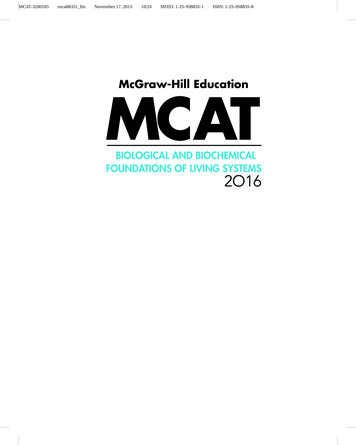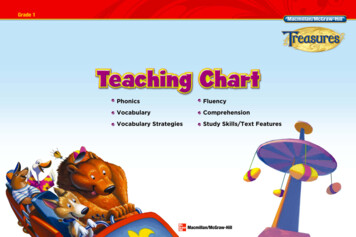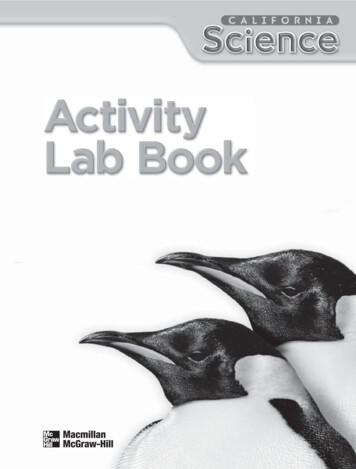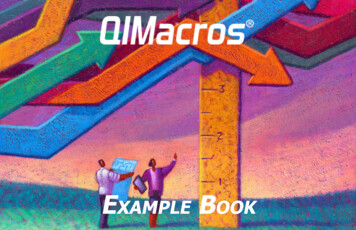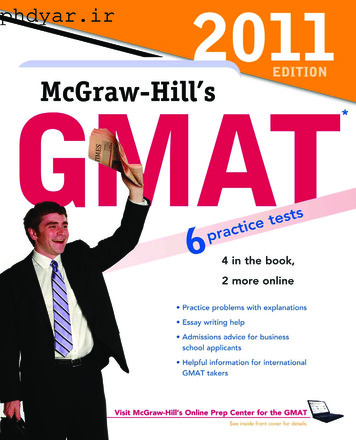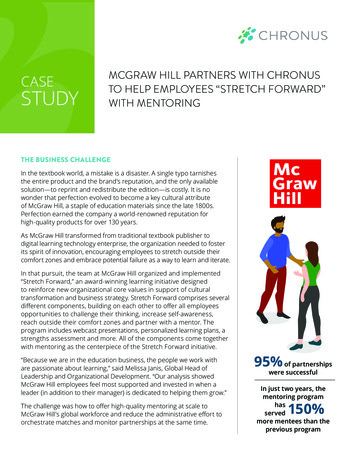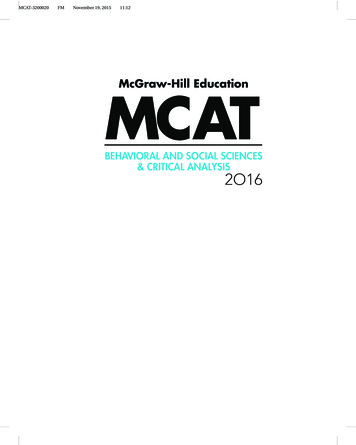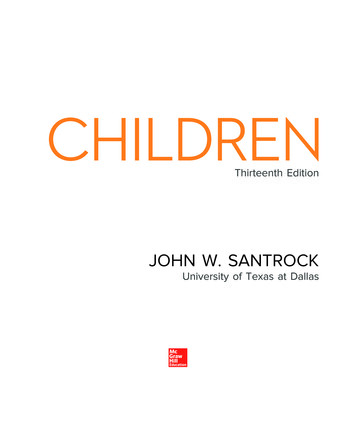
Transcription
san61833 fm i-xxvi.indd Page i 10/09/14 8:59 AM user/204/MH02193/San61833 disk1of1/0077861833/San61833 pagefilesCHILDRENThirteenth EditionJOHN W. SANTROCKUniversity of Texas at Dallas
san61833 fm i-xxvi.indd Page ii 25/09/14 10:38 AM userCHILDREN, THIRTEENTH EDITIONPublished by McGraw-Hill Education, 2 Penn Plaza, New York, NY 10121. Copyright 2016 by McGrawHill Education. All rights reserved. Printed in the United States of America. Previous editions 2013, 2010,and 2008. No part of this publication may be reproduced or distributed in any form or by any means, orstored in a database or retrieval system, without the prior written consent of McGraw-Hill Education,including, but not limited to, in any network or other electronic storage or transmission, or broadcast fordistance learning.Some ancillaries, including electronic and print components, may not be available to customers outsidethe United States.This book is printed on acid-free paper.1 2 3 4 5 6 7 8 9 0 DOW/DOW 1 0 9 8 7 6 5 4ISBN: 978-0-07-786183-4MHID: 0-07-786183-3Senior Vice President, Products & Markets: Kurt L. StrandVice President, General Manager, Products & Markets: Michael RyanVice President, Content Design & Delivery: Kimberly Meriwether DavidManaging Director: William R. GlassExecutive Director: Krista BettinoProduct Developer: Vicki Malinee, Van Brien & AssociatesMarketing Managers: Ann Helgerson and Augustine LaferreraLead Product Developer: Dawn GroundwaterDigital Product Developer: Sarah ColwellDirector, Content Design & Delivery: Terri SchieslProgram Manager: Debra HashContent Project Managers: Sheila M. Frank, Jodi BanowetzBuyer: Carol A. BielskiDesign: Trevor GoodmanContent Licensing Specialists: Carrie Burger, Leonard BehnkeCompositor: Aptara , Inc.Typeface: 9.5/12 Times LT StdPrinter: R. R. DonnelleyAll credits appearing on page or at the end of the book are considered to be an extension of the copyright page.Library of Congress Cataloging-in-Publication DataSantrock, John W.Children / John W. Santrock. — Thirteenth edition.pages cmISBN 978-0-07-786183-4 (alk. paper) — ISBN 0-07-786183-3 (alk. paper)1. Child development. 2. Adolescence. I. Title.HQ767.9.S268 2016305.231—dc232014035738The Internet addresses listed in the text were accurate at the time of publication. The inclusion of a websitedoes not indicate an endorsement by the authors or McGraw-Hill Education, and McGraw-Hill Educationdoes not guarantee the accuracy of the information presented at these sites.www.mhhe.com/204/MH02193/San61833 disk1of1/0077861833/San61833 pagefiles
san61833 fm i-xxvi.indd Page iii 10/09/14 8:59 AM user/204/MH02193/San61833 disk1of1/0077861833/San61833 pagefilesbrief contentsSECTION 1THE NATURE OF CHILDREN’S DEVELOPMENT 21SECTION 2BEGINNINGS 46234SECTION 3Physical Development in Early Childhood 221Cognitive Development in Early Childhood 245Socioemotional Development in Early Childhood 277MIDDLE AND LATE CHILDHOOD 313111213SECTION 6Physical Development in Infancy 123Cognitive Development in Infancy 159Socioemotional Development in Infancy 189EARLY CHILDHOOD 2208910SECTION 5Biological Beginnings 47Prenatal Development 75Birth 102INFANCY 122567SECTION 4Introduction 3Appendix: Careers in Children’s Development 41Physical Development in Middle and Late Childhood 314Cognitive Development in Middle and Late Childhood 341Socioemotional Development in Middle and Late Childhood 379ADOLESCENCE 414141516Physical Development in Adolescence 415Cognitive Development in Adolescence 445Socioemotional Development in Adolescence 475McGraw-Hill Psychology’s APA Documentation Style Guideiii
san61833 fm i-xxvi.indd Page iv 10/09/14 8:59 AM user/204/MH02193/San61833 disk1of1/0077861833/San61833 pagefilescontentsExpert ConsultantsxiiMaking Connections . . . From My Classroom to Children to YouProloguexvi1SECTION 1THE NATURE OF CHILDREN’S DEVELOPMENTC HAPT ER 1Theories of Child DevelopmentIntroduction 3CARING CONNECTIONS Strategies forParenting, Educating, and Interacting withChildren Based on Erikson’s Theory 20Research Methods for Collecting Data 27Research Designs 31Why Is Caring for Children Important? 5The Importance of Studying Children’sDevelopment 5Improving the Lives of Children 5CONNECTING WITH CAREERS Luis Vargas,Clinical Child Psychologist 6CONNECTING WITH DIVERSITY Gender,Families, and Children’s Development 9How Is Child Development a Science?The Importance of Research 16BEGINNINGSCONNECTING WITH RESEARCH Why AreResearch Journals Important in the Field ofChild Development? 34Research Challenges 35Reach Your Learning Goals38A P P ENDIXCareers in Children’sDevelopment 411646Infertility and Reproductive TechnologyAdoption 63C HAPT ER 2Biological Beginnings47What Are the Genetic Foundationsof Development? 52The Collaborative Gene 52Genes and Chromosomes 54Genetic Principles 55Chromosomal and Gene-Linked AbnormalitiesCONNECTING WITH CAREERSGenetic Counselor 60CONNECTING WITH DIVERSITY TheIncreased Diversity of Adopted Children andAdoptive Parents 64CARING CONNECTIONSChildren 6557Holly Ishmael,What Are Some Reproductive Challenges andChoices? 60Prenatal Diagnostic Tests 6062CONNECTING WITH RESEARCH Are ThereDevelopmental Outcomes in Adolescence ofIn Vitro Fertilization? 63What Is the Evolutionary Perspective? 49Natural Selection and Adaptive Behavior 49Evolutionary Psychology 50iv17CONNECTING WITH CAREERS Pam Reid,Educational and DevelopmentalPsychologist 36What Characterizes Development? 11Biological, Cognitive, and SocioemotionalProcesses 11Periods of Development 12Age and Cohort Effects 13Issues in Development 14SECTION 22Parenting AdoptedHow Do Heredity and Environment Interact? TheNature-Nurture Debate 66Behavior Genetics 66Heredity-Environment Correlations 67Shared and Nonshared EnvironmentalExperiences 68
san61833 fm i-xxvi.indd Page v 10/09/14 9:00 AM user/204/MH02193/San61833 disk1of1/0077861833/San61833 pagefilesMaternal Diseases 94Other Parental Factors 95The Epigenetic View and Gene 3 Environment(G 3 E) Interaction 69Conclusions About Heredity-EnvironmentInteraction 70Reach Your Learning GoalsReach Your Learning GoalsCH A P T ER 472Birth 102C HA P T ER 3Prenatal Development75What Is the Course of Prenatal Development?The Germinal Period 77The Embryonic Period 77The Fetal Period 79The Brain 8177What Are Some Important Strategies ThatEnhance the Expectant Mother’s Health andPrenatal Care? 82The Expectant Mother’s Nutrition andWeight Gain 82Exercise 83Prenatal Care 84CARING CONNECTIONS Exercise Guidelinesfor Expectant Mothers 85CONNECTING WITH CAREERS RachelThompson, Obstetrician/Gynecologist 86CONNECTING WITH DIVERSITYBeliefs About Pregnancy 88CulturalWhat Are Some Potential Hazards to PrenatalDevelopment? 89Some General Principles 89Prescription and Nonprescription Drugs 90Psychoactive Drugs 91CONNECTING WITH RESEARCH Is ExpectantMothers’ Cigarette Smoking Related toCigarette Smoking by Their AdolescentOffspring? 93Incompatible Blood Types 94Environmental Hazards 94SECTION 3INFANCY99What Happens During the Birth Process?Stages of the Birth Process 104Childbirth Setting and Attendants 104Methods of Childbirth 106CONNECTING WITH CAREERSPerinatal Nurse 107104Linda Pugh,CARING CONNECTIONS From Waterbirth toMusic Therapy 108The Transition from Fetus to Newborn 109What Are Some Measures of Neonatal Health andResponsiveness? 109How Do Low Birth Weight and Preterm InfantsDevelop? 111Preterm and Small for Date Infants 111CONNECTING WITH DIVERSITY Incidenceand Causes of Low Birth Weight Around theWorld 112Consequences of Preterm Birth and Low BirthWeight 112Nurturing Preterm Infants 113CONNECTING WITH RESEARCH How DoesMassage Therapy Benefit the Health and WellBeing of Babies? 114What Happens During the Postpartum Period? 115Physical Adjustments 115Emotional and Psychological Adjustments 116CONNECTING WITH CAREERS Diane Sanford,Clinical Psychologist and PostpartumExpert 117Bonding 118Reach Your Learning Goals119122C HA P T ER 5Physical Developmentin Infancy 123How Do Infants Grow and DevelopPhysically? 125Patterns of Growth 125Height and Weight 126The Brain 126Sleep 131Nutrition 133Health 136CARING CONNECTIONS Improving theNutrition of Infants and Young Children Livingin Low-Income Families 137CONNECTING WITH CAREERSBrazelton, Pediatrician 137T. BerryHow Do Infants Develop Motor Skills?The Dynamic Systems View 138Reflexes 139Gross Motor Skills 141Fine Motor Skills 143138CONNECTING WITH DIVERSITY CulturalVariations in Guiding Infants’ MotorDevelopment 143Contentsv
san61833 fm i-xxvi.indd Page vi 10/09/14 9:00 AM user/204/MH02193/San61833 disk1of1/0077861833/San61833 pagefilesHow Can Infants’ Sensory and PerceptualDevelopment Be Characterized? 145What Are Sensation and Perception? 145The Ecological View 146Visual Perception 146CONNECTING WITH RESEARCH How Can theNewborn’s Perception Be Studied? 147Other Senses 151Intermodal Perception 152Nature, Nurture, and Perceptual Development 153Perceptual-Motor Coupling 154Reach Your Learning GoalsCognitive Development inInfancy 159What Is Piaget’s Theory of InfantDevelopment? 161Cognitive Processes 161The Sensorimotor Stage 162Evaluating Piaget’s Sensorimotor Stage165CONNECTING WITH RESEARCH How DoResearchers Study Infants’ Understanding ofObject Permanence and Causality? 165How Do Infants Learn, Remember, andConceptualize? 168Conditioning 168Attention 168Memory 170Imitation 171Concept Formation 172How Are Individual Differences in Infancy Assessed,and Do These Assessments Predict Intelligence? 174Measures of Infant Development 174CONNECTING WITH CAREERS Toosje ThyssenVan Beveren, Infant Assessment Specialist 175Predicting Intelligence 175What Is the Nature of Language, and How Does ItDevelop in Infancy? 176Defining Language 176Language’s Rule Systems 176EARLY CHILDHOODPhysical Development inEarly Childhood 221How Does a Young Child’s Body and Brain Growand Change? 223Height and Weight 223The Brain 224ContentsCONNECTING WITH DIVERSITY LanguageEnvironment, Poverty, and LanguageDevelopment 183An Interactionist View 184CARING CONNECTIONS How Parents CanFacilitate Infants’ and Toddlers’ LanguageDevelopment 184Reach Your Learning Goals185Socioemotional Developmentin Infancy 189How Do Emotions and Personality Develop inInfancy? 189Emotional Development 189Temperament 195Personality Development 199CARING CONNECTIONS Parenting and theChild’s Temperament 199How Do Social Orientation/Understanding andAttachment Develop in Infancy? 201Social Orientation/Understanding 202Attachment and Its Development 203Individual Differences in Attachment 205Developmental Social Neuroscience andAttachment 208How Do Social Contexts Influence SocioemotionalDevelopment in Infancy? 209The Family 210Child Care 213CONNECTING WITH DIVERSITY Child-CarePolicies Around the World 214CONNECTING WITH CAREERS WandaMitchell, Child-Care Director 215CONNECTING WITH RESEARCH What AreSome Important Findings in the NationalLongitudinal Study of Child Care in the UnitedStates? 215Reach Your Learning Goals217220C HAPT ER 8vi180CH A P T ER 7155C HAPTER 6SECTION 4How Language Develops 178Biological and Environmental InfluencesHow Do Young Children’s Motor SkillsDevelop? 227Gross and Fine Motor Skills 227CARING CONNECTIONS Supporting YoungChildren’s Motor Development 228Perceptual Development 229Young Children’s Artistic Drawings 230
san61833 fm i-xxvi.indd Page vii 10/09/14 9:00 AM user/204/MH02193/San61833 disk1of1/0077861833/San61833 pagefilesWhat Are Some Important Aspects of YoungChildren’s Health? 232Sleep and Sleep Problems 232Nutrition 233Exercise 236Health, Safety, and Illness 237CONNECTING WITH CAREERS Yolanda Garcia,Head Start Director and College Dean 270Controversies in Early Childhood Education 271CONNECTING WITH DIVERSITY EarlyChildhood Education in Japan and DevelopingCountries 273Reach Your Learning GoalsCONNECTING WITH RESEARCH PhysicalActivity in Young Children AttendingPreschools 237CONNECTING WITH CAREERSDeloin, Pediatric Nurse 240CH A P T ER 1 0BarbaraCONNECTING WITH DIVERSITY The State ofIllness and Health in the World’s Children 241Reach Your Learning Goals242C HA P T ER 9Socioemotional Developmentin Early Childhood 277What Characterizes Young Children’s Emotionaland Personality Development? 279The Self 279Emotional Development 281CONNECTING WITH RESEARCH Caregivers’Emotional Expressiveness, Children’s EmotionRegulation, and Behavior Problems in HeadStart Children 283Moral Development 284Gender 287Cognitive Development inEarly Childhood 245What Are Three Views of the Cognitive ChangesThat Occur in Early Childhood? 247Piaget’s Preoperational Stage 247Vygotsky’s Theory 250CARING CONNECTIONS Tools of the Mind 253Information Processing 254What Roles Do Families Play in Young Children’sDevelopment? 290Parenting 290CONNECTING WITH CAREERS Darla Botkin,Marriage and Family Therapist 293Child Maltreatment 294Sibling Relationships and Birth Order 295The Changing Family in a Changing SocialWorld 297CONNECTING WITH RESEARCH Can ParentsSuggest False Events to Children? 257CONNECTING WITH CAREERS Helen Hadani,Developmental Psychologist, Toy Designer,and Child Museum Director 259How Do Young Children Develop Language?262CONNECTING WITH CAREERS Sharla Peltier,Speech Pathologist 263Understanding Phonology and Morphology 263Changes in Syntax and Semantics 264Advances in Pragmatics 265Young Children’s Literacy 265What Are Some Important Features of YoungChildren’s Education? 267Variations in Early Childhood Education 267Educating Young Children Who AreDisadvantaged 268SECTION 5274CARING CONNECTIONS Communicating withChildren About Divorce 300CONNECTING WITH DIVERSITY Immigrationand Ethnic Minority Parenting 302How Are Peer Relations, Play, and Media/Screen TimeInvolved in Young Children’s Development? 303Peer Relations 303Play 304Media/Screen Time 307Reach Your Learning GoalsMIDDLE AND LATE CHILDHOODC HA P T ER 11Physical Development in Middleand Late Childhood 314What Changes Take Place in Body Growth, theBrain, and Motor Development? 316Skeletal and Muscular Systems 316The Brain 316Motor Development 318309313What Are the Central Issues in Children’sHealth? 319Nutrition 319Exercise and Sports 319CARING CONNECTIONS Parents, Coaches,and Children’s Sports 321Overweight Children 321Diseases 323Contentsvii
san61833 fm i-xxvi.indd Page viii 10/09/14 9:00 AM user/204/MH02193/San61833 disk1of1/0077861833/San61833 pagefilesCARING CONNECTIONS ParentingStrategies for Helping Overweight ChildrenLose Weight 324CONNECTING WITH RESEARCHSmart 326Accidents and Injuries 326HeartCONNECTING WITH CAREERS SharonMcLeod, Child Life Specialist 327What Are the Prevalent Disabilities inChildren? 328Who Are Children with Disabilities? 328The Range of Disabilities 328Educational Issues 335C HAPTER 12Cognitive Developmentin Middle and LateChildhood 341What Is the Nature of Children’s InformationProcessing? 346Memory 346Thinking 348351How Can Children’s Intelligence BeDescribed? 353Intelligence and Its Assessment 353Types of Intelligence 354Interpreting Differences in IQ Scores 356Extremes of Intelligence 359CONNECTING WITH CAREERS Sterling Jones,Supervisor of Gifted and Talented Education 361What Changes in Language Development Occur inMiddle and Late Childhood? 363Vocabulary, Grammar, and MetalinguisticAwareness 363Reading and Writing 364Bilingualism and Second-Language Learning 366CONNECTING WITH DIVERSITY What Is theBest Way to Teach English LanguageLearners? 367viiiContents375CH A P T ER 13What Is the Nature of Emotional and PersonalityDevelopment in Middle and Late Childhood? 381The Self 381What Is Piaget’s Theory of Cognitive Developmentin Middle and Late Childhood? 343Concrete Operational Thought 343Evaluating Piaget’s Concrete Operational Stage 344Applications to Education 345CONNECTING WITH CAREERS SalvadorTamayo, Teacher of English LanguageLearners 367Reach Your Learning GoalsSocioemotional Developmentin Middle and LateChildhood 379338CARING CONNECTIONS Strategies forIncreasing Children’s Creative ThinkingMetacognition 351371CONNECTING WITH RESEARCH Parentingand Children’s Achievement: My Child Is MyReport Card, Tiger Moms, and Tiger BabiesStrike Back 373CONNECTING WITH DIVERSITYDisproportionate Representation of MinorityStudents in Special Education 337Reach Your Learning GoalsWhat Characterizes Children’sAchievement? 368Extrinsic and Intrinsic Motivation 368Sustained Attention, Effort, and TaskPersistence 369Mastery Motivation and Mindset 369Self-Efficacy 370Goal Setting, Planning, and Self-RegulationSocial Relationships and Contexts 371CARING CONNECTIONS Increasing Children’sSelf-Esteem 384Emotional Development 384Moral Development 387Gender 392What Are Some Changes in Parenting andFamilies in Middle and Late Childhood? 398Developmental Changes in Parent-ChildRelationships 398Parents as Managers 398Stepfamilies 399What Changes Characterize Peer Relationships inMiddle and Late Childhood? 400Developmental Changes 400Peer Status 400Social Cognition 402Bullying 402CONNECTING WITH RESEARCH How ArePerspective Taking and Moral MotivationLinked to Bullying? 404Friends 404What Are Some Important Aspects ofSchools? 405Contemporary Approaches to StudentLearning 406Socioeconomic Status and Ethnicity 407CONNECTING WITH DIVERSITY The NewHope Intervention Program 408CONNECTING WITH CAREERSChild Psychiatrist 410Reach Your Learning Goals411James Comer,
san61833 fm i-xxvi.indd Page ix 10/09/14 9:00 AM userSECTION 6/204/MH02193/San61833 disk1of1/0077861833/San61833 pagefilesADOLESCENCE414C HA P T ER 14Physical Developmentin Adolescence 415What Is the Nature of Adolescence? 417Positive and Negative Views of Adolescence 417Developmental Transitions 418What Are the Physical and Psychological Aspectsof Puberty? 420Sexual Maturation, Height, and Weight 421Hormonal Changes 421Timing and Variations in Puberty 422Psychological Dimensions of Puberty 423The Brain 424What Are the Dimensions of AdolescentSexuality? 426Developing a Sexual Identity 426Timing and Trends in Adolescent SexualBehavior 426Sexual Risk Taking in Adolescence 427CONNECTING WITH DIVERSITY CrossCultural Comparisons of AdolescentPregnancy 431CONNECTING WITH CAREERS LynnBlanknship, Family and Consumer ScienceEducator 432CARING CONNECTIONSPregnancy 432Reducing AdolescentHow Can Adolescents’ Health and HealthEnhancing Assets Be Characterized? 433Adolescent Health 433Leading Causes of Death in Adolescence 436Substance Use and Abuse 437CONNECTING WITH RESEARCH Evaluationof a Family Program Designed to ReduceDrinking and Smoking in YoungAdolescents 438Eating Problems and Disorders 440Reach Your Learning Goals442C HA P T ER 15Cognitive Development inAdolescence 445How Do Adolescents Think and ProcessInformation? 447Piaget’s Theory 447Adolescent Egocentrism 449Information Processing 450CONNECTING WITH CAREERS Laura Bickford,Secondary School Teacher 454What Characterizes Adolescents’ Values, MoralDevelopment and Education, and Religion? 455Values 455Moral Development and Education 456CONNECTING WITH RESEARCH Evaluating aService-Learning Program Designed toIncrease Civic Engagement 457Religion 460What Is the Nature of Schools forAdolescents? 462The American Middle School 462CONNECTING WITH CAREERS KatherineMcMillan Culp, Research Scientist at anEducational Center 464The American High School 464CONNECTING WITH DIVERSITY CrossCultural Comparisons of SecondarySchools 466CARING CONNECTIONS The “I Have aDream” Program 468How Do Adolescents Experience CareerDevelopment? 468Developmental Changes 469Exploration, Decision Making, and PlanningSociocultural Influences 469469CONNECTING WITH CAREERS ArmandoRonquillo, High School Counselor/CollegeAdvisor 470Reach Your Learning Goals472CH A P T ER 1 6Socioemotional Developmentin Adolescence 475What Characterizes Identity and EmotionalDevelopment in Adolescence? 477Identity 477Emotional Development 481What Is the Nature of Parent-AdolescentRelationships? 483Parental Monitoring and Adolescents’ InformationManagement 483Autonomy and Attachment 484Parent-Adolescent Conflict 485CARING CONNECTIONS Strategies forParenting Adolescents 486What Aspects of Peer Relationships Are Importantin Adolescence? 487Friendship 487Peer Groups 488Dating and Romantic Relationships 489Contentsix
san61833 fm i-xxvi.indd Page x 10/09/14 9:00 AM userWhy Is Culture an Important Context forAdolescent Development? 492Cross-Cultural Comparisons 492CONNECTING WITH DIVERSITY HowAdolescents Around the World Spend TheirTime 494Ethnicity 495Media and Technology 496What Are Some Socioemotional Problemsin Adolescence? 498Juvenile Delinquency 498CONNECTING WITH CAREERS RodneyHammond, Health Psychologist 500Depression and Suicide 500xContents/204/MH02193/San61833 disk1of1/0077861833/San61833 pagefilesThe Interrelation of Problems and SuccessfulPrevention/Intervention Programs 503CONNECTING WITH RESEARCHTrack 504Reach Your Learning GoalsFast505McGraw-Hill Psychology’sAPA Documentation Style GuideGlossary G-1References R-1Credits C-1Name Index N-1Subject Index S-1
san61833 fm i-xxvi.indd Page xi 10/09/14 9:00 AM user/204/MH02193/San61833 disk1of1/0077861833/San61833 pagefilesabout the authorJohn W. SantrockJohn Santrock received his Ph.D. from the University of Minnesota. He taught at theUniversity of Charleston and the University of Georgia before joining the Program inPsychology at the University of Texas at Dallas, where he currently teaches a numberof undergraduate courses and was recently given the University’s Effective TeachingAward. In 2010, he created the UT-Dallas Santrock undergraduate scholarship, anannual award that is given to outstanding undergraduate students majoring in develJohn Santrock, teaching an undergraduate class.opmental psychology to enable them to attend research conventions.John has been a member of the editorial boards of Child Development andDevelopmental Psychology. His research on father custody is widely cited and usedin expert witness testimony to promote flexibility and alternative considerations incustody disputes. John also has authored these exceptional McGraw-Hill texts:Life-Span Development (15th edition), Adolescence (15th edition), A Topical Approachto Life-Span Development (7th edition), and Educational Psychology (5th edition).For many years, John was involved in tennis as a player, teaching professional,and coach of professional tennis players. At the University of Miami (FL), the tennisteam on which he played still holds the NCAA Division I record for most consecutivewins (137) in any sport. His wife, Mary Jo, has a master’s degree in special educationand has worked as a teacher and a Realtor. He has two daughters—Tracy, who alsois a Realtor, and Jennifer, who is a medical sales specialist. He has one granddaughter,Jordan, age 21, currently a graduate student in Cox School of Business at SouthernMethodist University, and two grandsons, Alex, age 9, and Luke, age 7. In the lasttwo decades, John also has spent time painting expressionist art.Dedication:With special appreciation to my grandchildren:Jordan, Alex, and Luke.Jordan Bowles.Alex and Luke, the Bellucci Brothers.xi
san61833 fm i-xxvi.indd Page xii 10/09/14 9:00 AM user/204/MH02193/San61833 disk1of1/0077861833/San61833 pagefilesexpert consultantsChildren’s development has become an enormous, complex field, and no single author, or even several authors, can possibly keep up with all of the rapidlychanging content in the many periods and different areas of life-span development. To solve this problem, author John Santrock has sought the input ofleading experts about content in a number of areas of children’s development. These experts have provided detailed evaluations and recommendations intheir area(s) of expertise.The following individuals were among those who served as expert consultants for one or more of the previous editions of this text:Urie Bronfenbrenner, Cornell UniversityDiana Baumrind, University of California–BerkeleyTiffany Field, University of MiamiScott Johnson, University of California–Los AngelesNel Noddings, Stanford UniversityRoss Thompson, University of California–DavisSandra Graham, University of California–Los AngelesJames Marcia, Simon Fraser UniversityJohn Bates, Indiana UniversityFlorence Denmark, Pace UniversityRosalind Charlesworth, Weber State UniversityDavid Sadker, The American University–Washington DCMarilou Hyson, University of PennsylvaniaAlgea Harrison-Hale, Oakland UniversityCampbell Leaper, University of California-Santa CruzJanet DiPietro, Johns Hopkins UniversityAllan Wigfield, University of Maryland–College ParkBarbara Pan, Harvard UniversityPeter Scales, Search InstituteFollowing are the expert consultants for the thirteenth edition, who (like those of previous editions) literally represent a Who’s Who in the field of childand adolescent development.Elizabeth Trejos-CastilloDr. ElizabethTrejos-Castillo is an expert on diversity, culture, andadolescent development. She currently is a professor inHuman Development and Family Studies at Texas TechUniversity. Her research interests mainly focus onrisk-taking and adjustment in youth as well as generational,individual and contextual effects in adolescent development. Her researchapproach is rooted in psychology, sociology, and human development usingcross-cultural and evidence-based research methodologies. Dr. TrejosCastillo is an associate editor of The Journal of Early Adolescence.“I’m definitely impressed with the vast literature covered in bothChapters 13 and 16 . . . the scholarly work and theories described arewell illustrated using cross-cultural/cross-national studies which providestudents with a well-rounded, inclusive view of development of childrenand adolescents around the globe. . . . The author provides a wellbalanced literature review that discusses seminal work and at the sametime introduces the most up-to-date scholarship. . . . I personally enjoyvery much the conversational tone of the narrative and the easiness withwhich John Santrock connects and integrates different topics acrosschapters”—Elizabeth Trejos-CastilloDavid Moore Dr. Moore is a leading expert ongenetic/environmental influences on development and infant perceptual/cognitive development. He obtained aPh.D. in developmental and biological psychology fromHarvard University. After completing a postdoctoralfellowship at the City University of New York, he joinedthe faculties of Pitzer College and Claremont Graduate University, wherehe currently is a professor of psychology. His book, The Dependent Gene,was widely adopted for use in undergraduate education, was translatedinto Japanese, and was nominated for the Cognitive DevelopmentSociety’s Best Authored Volume award. Dr. Moore’s empirical researchhas produced publications on infants’ reactions to infant-directed speech,on the development of spatial cognition, and on infants’ rudimentaryxiiperception of numerical quantities. His theoretical writings have exploredthe contributions of genetic, environmental, and epigenetic factors tohuman development; his chapter “Genetics, Behavior Genetics, andEpigenetics” appeared in 2013 in the Oxford Handbook of DevelopmentalPsychology, and his new book on behavioral epigenetics was published byOxford University Press in 2014. He serves on the editorial board of ChildDevelopment Perspectives.“The narrative and perspective effectively reflect the latest and mostimportant research. . . . I think John Santrock has done a great job inciting the latest research. . . . his efforts to connect ideas across chapters,to connect developmental processes across different stages, and to connectthe information conveyed in the book to readers’ real lives will pay off.—David MooreElizabeth Gershoff Elizabeth Gershoff is aleading expert on the social contexts, especially familycontexts, of child and adolescent development. Sheobtained a Ph.D. in child development and familyrelationships from the University of Texas at Austinand currently is a professor in Human Developmentand Family Sciences there. Dr. Gershoff’s current research interests andexpertise center on four topics: (1) how parental discipline affects childand youth development; (2) how contexts of poverty, neighborhoods,schools, and cultures affect children, youth, and families; (3) how exposureto various forms of violence (from parents, communities, and terrorism)affect child and youth development; and (4) how enriched early childhoodeducational environments can improve the lives of low-income childrenand their families. She co-edited Societal Contexts of Child Development(2014), published by Oxford University Press.“The narrative and perspective reflect the latest and most importantresearch in the field. . . . the citations are current and reflect current theoryand recent findings. . . . readers will get a good overview of the topicsand studies. The sections on theories and research methods are strong.”—Elizabeth Gershoff
san61833 fm i-xxvi.indd Page xiii 11/09/14 6:01 PM f-500Candice MillsDr. Mills is a leading expert onsocial cognition in children’s development. She obtainedher Ph.D. in developmental psychology from YaleUniversity and currently is a professor in the School ofBehavioral and Brain Sciences at the University of Texasat Dallas. In 2011, she was the recipient of a Universityof Texas System Regents’ Outstanding Teaching Award. Dr. Mills’ research examines how children learn from others, exploring developmental changes in children’s ability to evaluate the quality of the informationthey encounter and in their ability to use questions to gather informationfrom others. Her recent publications include articles in research journalssuch as Child Development, Developmental Psychology, and Developmental Science.“Throughout each chapter, Dr. Santrock provides scaffolding to enrichstudents’ learning. Key learning goals are emphasized, and connectionsto other chapters as well as to more general ideas are provided.Helping students to put their reading in context, Dr. Santrock describesclassic research and theoretical
12 Cognitive Development in Middle and Late Childhood 341 . Adolescence 415 15 Cognitive Development in Adolescence 445 16 Socioemotional Development in Adolescence 475 McGraw-Hill Psychology's APA Documentation Style Guide . CARING CONNECTIONS Tools of the Mind 253 Information Processing 254 CONNECTING WITH RESEARCH Can Parents


